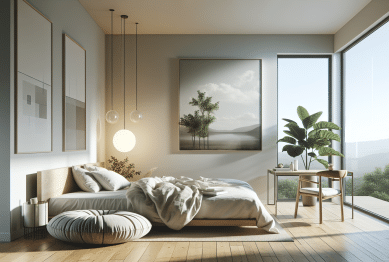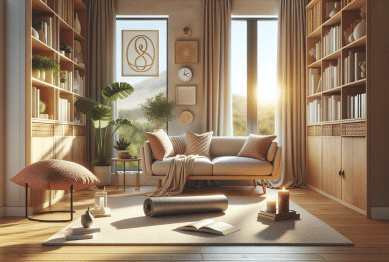Minimalist living isn’t just about decluttering your home; it’s a mindset shift with positive ripple effects. Explore practical minimalism tips to refresh your lifestyle, discover psychological benefits, and learn how this trending style helps many people find more meaning in their everyday experiences without sacrificing comfort.
Understanding the Appeal of Minimalist Living
Minimalist living continues to captivate people ready to simplify and enrich their everyday lives. The approach centers on reducing material possessions and prioritizing meaningful experiences. Instead of filling rooms with nonessential items, many discover peace in open spaces, streamlined furniture, and carefully selected decor pieces. This lifestyle’s growing popularity highlights society’s shift toward valuing quality over quantity. From social media influencers to bestselling authors, the draw of a clutter-free space and mindful consumerism resonates widely. By intentionally curating what enters their homes, individuals can experience greater satisfaction in what remains—from favorite books to cherished art—while creating environments that feel relaxing and controlled.
Many people initially turn to minimalism seeking relief from household disorganization and the stress that often comes with too much clutter. Surprisingly, removing just a portion of possessions can have a profound effect on mental well-being. Research from the National Institute of Mental Health suggests that organized, clean environments are linked to lower levels of anxiety and improved focus (Source: https://www.nimh.nih.gov). Inviting minimalism into your life doesn’t mean living without; rather, it involves actively choosing what serves a positive purpose—and releasing the rest. Even small efforts, such as clearing an overstuffed closet or creating a calm entryway, can start this transformation.
The aesthetic side of minimalism also holds strong appeal. Crisp lines, neutral tones, and thoughtfully arranged pieces help create soothing interiors and functional layouts. For many, a minimal approach to decor highlights the architecture of a home while making daily routines simpler. Whether in a compact city apartment or a sprawling suburban house, minimalist living adapts to nearly any space. Online communities further amplify this movement, providing support, inspiration, and real-life examples of families, singles, and retirees who make minimalist principles work for them.
Starting Your Journey: The First Steps Toward Minimalism
Taking the first steps toward a minimalist lifestyle can feel daunting, especially if sentimental attachment to possessions is strong. Start with small, manageable areas—like a single kitchen drawer, entryway shelf, or bathroom cabinet. Experts at the Mayo Clinic suggest setting aside dedicated time for decluttering can prevent overwhelm and make progress feel more achievable (Source: https://www.mayoclinic.org). Create simple criteria: if an item hasn’t been used in six months or does not spark a sense of purpose, consider letting it go. This thoughtful approach turns downsizing into a mindful process, rather than a hurried purge.
As you continue, reflect on personal values and what truly adds meaning to everyday life. Minimalism is not a one-size-fits-all trend. While some focus on reducing digital clutter or embracing capsule wardrobes, others prioritize simplifying finances or leisure time. Try journaling to identify stress triggers associated with clutter, then build a plan for gradual improvement. Surrounding yourself with supportive friends or following minimalist creators online can supply encouragement and practical advice, making it easier to stay motivated and accountable on your journey.
Many discover that decluttering also opens doors to financial flexibility and less impulsive spending. Instead of viewing minimalism as a sacrifice, it helps to see it as an investment in well-being. Reducing unnecessary purchases saves money, cuts down on decision fatigue, and gives more room for experiences that matter. Some minimalists even frame their journey as a pathway to intentional living—where choices around money, time, and energy are more closely aligned with long-term goals or personal happiness.
The Psychological Benefits of Minimalism
Embracing minimalist living can lead to unexpected mental health benefits. Studies from the University of California reveal that disorganized, cluttered environments may elevate cortisol—the body’s main stress hormone—resulting in heightened anxiety and disrupted sleep patterns (Source: https://www.universityofcalifornia.edu). Minimalist homes, with their uncluttered surfaces and open spaces, subconsciously offer visual cues of calmness and control. Living in such settings encourages mindful awareness and helps many people feel more present and clear-headed. Over time, reducing both physical and mental clutter can improve emotional resilience and capacity for joy.
Another psychological advantage involves decision-making. Fewer possessions mean fewer daily choices—known by psychologists as ‘decision fatigue.’ Decluttering wardrobes, kitchens, and workspaces reduces the overwhelm that comes from constant decision-making, freeing up mental energy for creative pursuits or problem-solving. Children and teens also benefit from minimalism; simple, organized environments can improve focus, encourage independent play, and reduce distractions during study or family time. In workplaces, even small steps toward simplifying scenery can drive productivity and satisfaction.
Ultimately, the minimalist mindset strengthens self-awareness. It encourages asking questions about wants versus needs, genuine preferences, and lifestyle values. Many people find that as they practice minimalism, they become more intentional in all life areas—including relationships, health habits, and leisure activities. This holistic change often brings a sense of freedom and self-mastery, as the external order mirrors internal clarity. The lifestyle is less about deprivation and more about gaining heightened appreciation for what is truly essential.
Minimalism in Home Design and Decor
Minimalist home design draws inspiration from Japanese aesthetics and Scandinavian simplicity. The goal is to create peaceful, functional environments that support relaxation and focus. Design experts recommend favoring multi-use furniture, concealed storage, and neutral color palettes to achieve visual harmony (Source: https://www.architecturefoundation.org.uk). Consider starting with a single room—like the bedroom or living area—by removing unused decor, arranging furniture for easy movement, and introducing one or two statement pieces. Clean lines and natural lighting further highlight the space’s architectural features without distraction.
Incorporating greenery is a favorite technique among minimalist designers. Plants double as decor and air purifiers, adding vibrancy and a sense of serenity. When selecting items to keep, a “one in, one out” practice helps prevent clutter from returning. Minimalist design doesn’t have to feel cold or impersonal; adding textured fabrics, handcrafted ceramics, or beloved artwork can infuse warmth and personality. The key lies in intentional curation—arranging possessions so each item is visible and functional, rather than hidden or forgotten in overfilled cabinets.
Minimalist design also supports sustainability and responsible consumption. By focusing on durable, well-crafted goods instead of frequent, trend-driven purchases, households naturally reduce waste and environmental impact. This aligns with data from the Environmental Protection Agency, which links household consumption to broader ecological outcomes (Source: https://www.epa.gov). The reward: a visually appealing, functional, and environmentally conscious living space that feels uniquely yours.
Digital Minimalism: Simplifying the Virtual World
Minimalist living goes beyond physical spaces; it can also shape how technology is used day to day. Digital minimalism focuses on reducing screen clutter, limiting nonessential notifications, and intentionally selecting digital tools that add value. For instance, streamlining your phone’s home screen or paring back social media usage can lower stress and improve focus. Harvard Health notes that setting screen time boundaries helps maintain a healthier balance between real-life experiences and digital engagement (Source: https://www.health.harvard.edu). By prioritizing essential apps and turning off irrelevant alerts, the digital environment becomes just as organized as the home.
Another aspect of digital minimalism involves mindful consumption of information. With news, emails, and entertainment available around the clock, it’s easy to become overwhelmed or distracted. Creating habits like batching email checks, unfollowing unnecessary accounts, or maintaining a minimalist desktop can free up mental space and time. Many find that this digital clarity allows them to rediscover offline hobbies, connect more deeply with friends, and reduce sleeplessness linked with late-night screen time.
Importantly, digital minimalism encourages regular “detox” days—times without screens or tech interruptions. These breaks have been shown to lower anxiety, spark creativity, and deepen relationships. Over time, a streamlined virtual life supports more meaningful engagement IRL (in real life), amplifying the positive impact of overall minimalist living.
Challenges and Solutions in Minimalist Living
No lifestyle shift occurs without challenges. Minimalist living confronts deeply ingrained habits, cultural expectations, and sometimes resistance from family or roommates. There can be guilt associated with discarding items given as gifts, or difficulty letting go of objects tied to memories. Experts from the American Psychological Association suggest reframing these decisions by honoring the memory and separating it from the physical item (Source: https://www.apa.org). Taking photos of sentimental objects or donating them to someone in need can offer closure and a sense of contribution.
Social influences also shape the ease of adopting minimalism. In a culture that celebrates abundance, embracing “less” often means adjusting expectations and occasionally explaining choices to friends or relatives. Open conversations help clarify that minimalism is about happiness and intentionality—not deprivation. Creating shared household guidelines or tackling group projects, like decluttering a living room together, can foster teamwork and support. Over time, the consistency of daily practice—putting things away, rethinking new purchases—builds momentum and resilience in the face of setbacks.
Minimalist living is flexible. It doesn’t demand perfection. Each person interprets and adapts the philosophy based on circumstances, needs, and preferences. Even after initial decluttering, regular reviews can help maintain a harmonious environment. This kind of adaptability ensures the lifestyle remains enjoyable, relevant, and beneficial, even as priorities and seasons of life change.
References
1. National Institute of Mental Health. (n.d.). Stress and Mental Health. Retrieved from https://www.nimh.nih.gov
2. Mayo Clinic. (n.d.). Decluttering your physical space for mental well-being. Retrieved from https://www.mayoclinic.org
3. University of California. (n.d.). The effect of clutter on the brain. Retrieved from https://www.universityofcalifornia.edu
4. Architecture Foundation. (n.d.). The Minimalist Home: Principles and Practice. Retrieved from https://www.architecturefoundation.org.uk
5. Environmental Protection Agency. (n.d.). Sustainable Consumption and the Environment. Retrieved from https://www.epa.gov
6. Harvard Health. (n.d.). Screen time, technology and your mental health. Retrieved from https://www.health.harvard.edu











 Why Slow Living Could Change Your Everyday Happiness
Why Slow Living Could Change Your Everyday Happiness 

